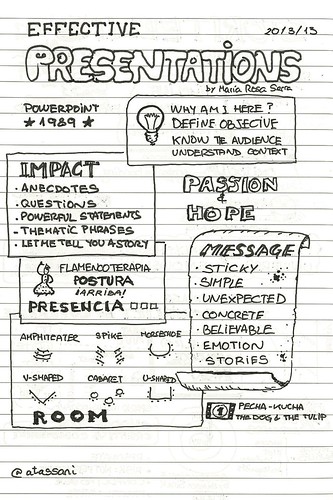I'm a visual guy, and I love drawing. I've always though that any idea with an image is easier to understand, and that presentation is key. When I came across Mind Mapping as a technique to take notes I run to my bookstore to buy Tony Buzan's Book. I loved the idea of radiant thinking but I found that maps without images were not that powerful.
I was amazed in the Barcelona Leancamp about the notes that a girl was taking. She was drawing! Esther Gons (@wilg) is an artist, of course, but I though I could try something similar. What I needed was some some visual vocabulary.
Dan Roam's The Back of Napkin came to my hands, introducing the idea of communicating using images. The book contains a lot of inspiring ideas, but still lacked guidance about how to draw simple images (and what to draw).
Later I discovered the book Gamestorming (thanks to the Barcelona Meetup), and Visual Facilitation: using drawings in meetings to create and communicate ideas. They suggested that drawing is easy, and that everything can be drawn based on lines, circles an squares. A lot of inspiration again, but not an easy path.
Finally I came across with a great book, Mike Rodhe's The Sketchnote Handbook. What a great book!!! It has a beautiful presentation, it's very easy to read, and the book is presented using the same techniques the author explains. You can see different styles from different authors and you feel confident trying. It's not about art, but about structure.
Now I take notes using drawings in all the meetings, events and conferences I attend. And I try to practice, copy and try new things. I enjoy drawing with my kids simple things, enhancing my vocabulary. I love it!
Now I enjoy meetings, I'm more focused and I try to get the main ideas.
And I love it so much that I bought a copy for my sister.
Sketchnoting is not about beautiful drawings, but about structure, boxes and arrows. Using different typographies also help and the book suggests a lot of things to practice.
One of the best things I've got from the book is the name, a name for the thing: sketchnote, sketchnoting. Now I can find examples, track the Sketchnote Army, find examples in Pinterest, or other good advices.
I've also seen Sunni Brown (Gamesorming book author) using Visual Notetaking, and Doodling to refer to the same concept. It's worth to have a look at her TED Talk, "Doodlers, unite!".
I'll go on having fun with my sketchnoting experiments. Regarding the tools, I'm trying with gel pens, Faber-Castell PITT pens, in Moleskine notebooks small and medium sized. I share some of my experiments at my Flicker.
Go, draw, learn and have fun!

